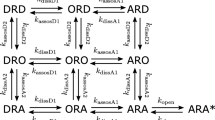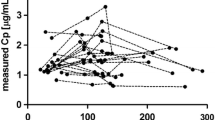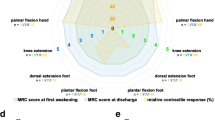Repeated motor nerve stimulation performed during neuromuscular monitoring enhances the evoked mechanical response of the corresponding muscle resulting in an increased twitch response. This is known as twitch potentiation or the staircase phenomenon. For neuromuscular modelling research twitch stabilisation techniques are often used to reduce the visible effect of potentiation, but such techniques are not always effective. Our objective was to model pharmacokinetic-pharmacodynamic (PK–PD) and twitch potentiation and to estimate neuromuscular block (NMB) in the presence of twitch potentiation. We combined a standard PK–PD model with a model describing the degree of twitch potentiation. The combined model was used to predict mechanomyographic twitch measurements and estimate NMB and twitch potentiation during muscle relaxation monitoring. Model parameters and prediction accuracy were compared to the standard PK–PD model with and without linear baseline correction. The PK–PD-potentiation model allows NMB to be estimated in the presence of twitch potentiation. It also accurately predicts data from twitch stabilisation, which is ignored with the standard PK–PD model. Compared to the standard PK–PD model, estimated PD parameters ec50 and gamma were found to be higher using the PK–PD-potentiation model. Compared to linear baseline correction, estimated PD parameters ke0 and ec50 were found to be higher. A PK–PD-potentiation model can estimate the degree of twitch potentiation and the degree of NMB during neuromuscular monitoring. This model leads to different PD parameter estimations than the standard PK–PD model however the differences are small enough to be unlikely to cause great concern among researchers.
Similar content being viewed by others
References
C. J. Hull H. B. H. Van Beem K. McLeod A. Sibbald M. J. Watson (1978) ArticleTitleA pharmacodynamic model for pancuronium Br. J. Anaesth 50 1113–23 Occurrence Handle718781
L. B. Sheiner D. R. Stanski S. Vozeh R. D. Miller J. Ham (1979) ArticleTitleSimultaneous modeling of pharmacokinetics and pharmacodynamics: application to d-tubocurarine Clin. Pharmacol. Ther. 25 358–71 Occurrence Handle761446
C. Krarup (1981) ArticleTitleEnhancement and diminution of mechanical tension evoked by staircase and by tetanus in rat muscle J. Physiol. 311 355–72 Occurrence Handle7264972
J. M. Ritchie D. R. Wilkie (1955) ArticleTitleThe effect of previous stimulation on the active state of muscle J. Physiol. 130 488–496 Occurrence Handle13278915
G. Van Santen V. Fidler J. M. K. H. Wierda (1998) ArticleTitleStabilization of twitch force during mechanomyography of the adductor pollicis muscle J. Clin. Monit. Comput. 14 457–63 Occurrence Handle10.1023/A:1009915201811 Occurrence Handle10385853
A. F. Kopman S. Kunmar M. M. Klewicka G. G. Neuman (2001) ArticleTitleThe staircase phenomenon Anesthesiology 95 403–407 Occurrence Handle10.1097/00000542-200108000-00023 Occurrence Handle11506113
D. J. Eleveld A. F. Kopman J. H. Proost J. M. K. H. Wierda (2004) ArticleTitleModel to describe the␣degree of twitch potentiation during neuromuscular monitoring Br. J. Anaesth. 92 373–380 Occurrence Handle10.1093/bja/aeh056 Occurrence Handle14742345
J. Viby-Mogensen J. Engbaek L. I. Eriksson L. Gramstad E. Jensen F. S. Jensen Z. Koscielniak-Nielsen L. T. Skovgaard D. Ostergaard (1996) ArticleTitleGood clinical research practice (GCRP) in pharmacodynamic studies of neuromuscular blocking agents Acta. Anaesth. Scand. 40 59–74 Occurrence Handle8904261
A. De Haes J. H. Proost J. B. M. Kuks D. C. Vanden Tol J. M. K. H. Wierda (2002) ArticleTitlePharmacokinetic–pharmacodynamic modeling of rocuronium in myasthenic patients is improved by taking into account the number of unbound acetylcholine receptors Anest. Analg. 95 IssueID3 588–596 Occurrence Handle10.1097/00000539-200209000-00018
F. Mentre R. Gomeni (1995) ArticleTitleA two-step iterative algorithm for estimation in nonlinear mixed-effect models with an evaluation in population pharmacokinetics J. Biopharm. Stat. 5 141–158 Occurrence Handle7581424
J. E. Bennett J. C. Wakefield (1996) ArticleTitleA comparison of Bayesian population method with two methods as implemented in commercially available software J. Pharmacokinet. Biopharm. 24 403–432 Occurrence Handle9044168
H. L. Sweeney B. F. Bowman J. T. Stull (1993) ArticleTitleMyosin light chain phosphorylation in vertebrate striated muscle: regulation and function Am. J. Physiol. Cell Physiol. 264 C1085–C1095
G. A. Klug B. R. Botterman J. T. Stull (1982) ArticleTitleThe effect of low frequency stimulation on myosin light chain phosphorylation in skeletal muscle J. Biol. Chem. 257 4688–4690 Occurrence Handle7068657
G. C. Lee S. Iyengar J. Szenohradszky J. E. Caldwell P. M. C. Wright R. Brown M. Lau A. Luks D. M. Fisher (1997) ArticleTitleImproving the design of muscle relaxant studies: Stabilization period and tetanic recruitment Anesthesiology 86 48–54 Occurrence Handle10.1097/00000542-199701000-00008 Occurrence Handle9009939
R. L. Moore J. T. Stull (1984) ArticleTitleMyosin light chain phosphorylation in fast and slow skeletal muscles in situ Am. J. Physiol. 247 C462–C471 Occurrence Handle6548609
Author information
Authors and Affiliations
Corresponding author
Rights and permissions
About this article
Cite this article
Eleveld, D.J., Proost, J.H., De Haes, A. et al. Improving Pharmacokinetic–Pharmacodynamic Models of Muscle Relaxants Using Potentiation Modelling. J Pharmacokinet Pharmacodyn 32, 143–154 (2005). https://doi.org/10.1007/s10928-005-2106-8
Received:
Accepted:
Issue Date:
DOI: https://doi.org/10.1007/s10928-005-2106-8




